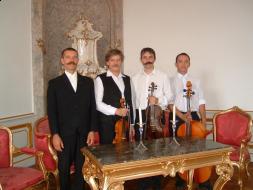
Jánosi Ensemble
András Jánosi violin
András Túri viola, gardon
István Tóth bass, drum
Tamás Nyitrai violin (guest)
Miklós Szűcs vokal, bagpipe (guest)
“Those who took part at the Liszt-concert of the Jánosi Ensemble at december 21, could listen to one of the most exciting and most inspiring undertakings of the Liszt-Year.” Tamás Váczy
The Jánosi Ensemblecontinues the more than a two hundred and fifty year tradition of Hungarian instrumental music. The reminiscences of the Hungarian dance music heritage of a thousand years has been preserved mostly by oral tradition up to the 21st century. But the Hungarian dance melodies played on the violin are for nearly three hundred years to be found in our manuscripts of dances.
The Ensemble would like to make you acquainted, besides the traditional folk dance music of the Hungarian regions, also with the melodies of the mentioned musical collections.
Hungarian musical tradition is to be found on various places, the search of their fragments as well as their collections has been continued up till now. The Ensemble too has joined this work. It has arranged remarkable success above all in revealing the particularities of rendering the different musical dialects documented by the records of the Ensemble.
The first complete success of the Ensemble was the theatrical performance which demonstrated the sources of Bartók’s works on folk music. The programme which had been proceeded by the searching work of several years was accepted enthusiastically not only by the audience but also by the critique. This is proof that since its first appearance on the stage (1981) several variations have been performed not only in Hungary but abroad too.
From the middle of the eighties the most important field of the Ensemble’s activity has been to present the past of the Hungarian instrumental folk music tradition. Dance music played on stringed instruments in Hungarian villages is rooted in the 18th century Hungarian musical traditions. This earlier supposition had been proved by JÁNOSI, András by comparative analysis of hundred and hundred melodies.
In the course of this work light has been thrown on the Rhapsodies of Liszt (and other contemporary works), on earlier unknown folk music relations, on the 18th century roots of the Hungarian instrumental folk music, proving that the Hungarian village musicians have preserved, together with the 18th century melodies, even the rendering of contemporary string playing. The programmes of the Ensemble connected with this theme are based on the latest results of musical research, at the same time they worthy can reckon on the interest of the general public through their popular, unambiguous style.







































